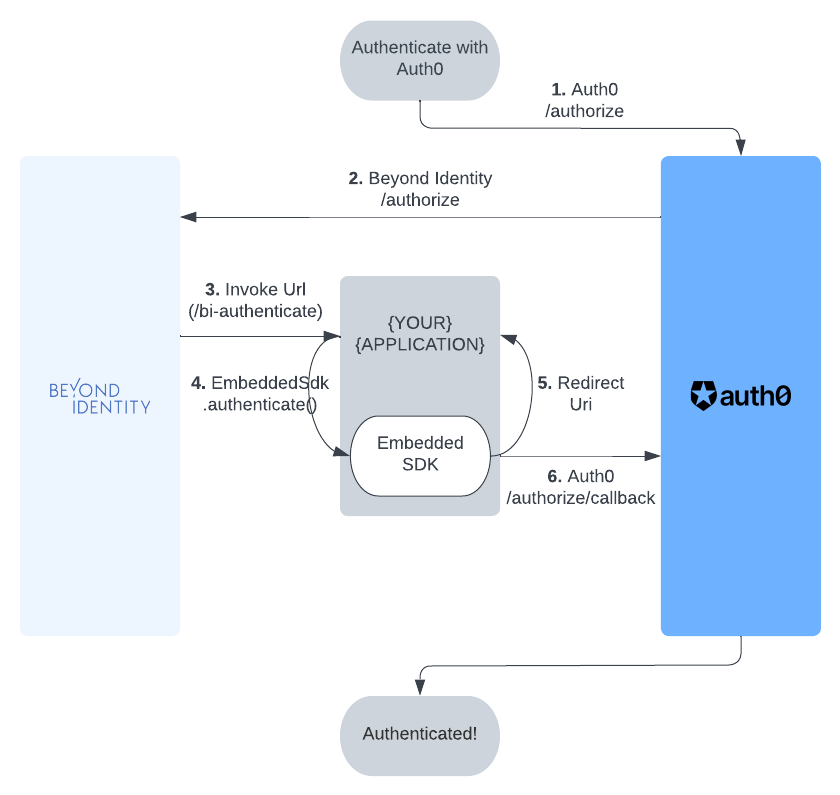Integrate With Auth0
This guide describes how to configure Auth0 to delegate to Beyond Identity for authentication during an OAuth2 authorization flow.
Prerequisites
Before calling Embedded.authenticate, we must Authorize With Auth0.
Authorize With Auth0

Using an SDK
See Auth0's Developer Site for the latest React Native SDKs or Widgets.
Note: At this time, there is no way to intercept the first URL to authenticate with Beyond Identity, so we recommend using the Web.
Using the Web
Pick a webview library that follows the best practices set out in RFC 8252 - OAuth 2.0 for Native Apps. The library should use SFAuthenticationSession and SFSafariViewController on iOS and Custom Tabs on Android for authorization requests. UIWebView and WKWebView on iOS and WebView on Android are explicitly not supported due to the security and usability reasons explained in Section 8.12 of RFC 8252. For these reasons, unfortunately, the react-native-community/react-native-webview is not recommended. The below examples will use InAppBrowser:
- Step 1: Configuring the Authenticator Config
Make sure the Authenticator Config in the Beyond Identity Console is set to type Embedded and that the Invoke URL points to your application with either an App Scheme or a Universal Link.
- Step 2: Auth0 Authorize URL
To start the authorization flow, build a CustomTabsIntent or ASWebAuthenticationSession, and load the OAuth2 authorization request URL provided by Auth0. Make sure whichever webview you use shares cookies and other browsing data between the authentication session. The below example sets ephemeralWebSession to false to enable cookie re-use on iOS.
if (await InAppBrowser.isAvailable()) {
let response = await InAppBrowser.openAuth(auth0AuthUrl, 'yourScheme://', {
ephemeralWebSession: false,
});
}
- Step 3: Invoke URL
During the first web session, a URL with the invoke URL scheme should be returned from Auth0.
Call Embedded.authenticate with this url. You can confirm the validity of the URL with Embedded.isAuthenticateUrl.
if (await InAppBrowser.isAvailable()) {
const response = await InAppBrowser.openAuth(auth0AuthUrl, 'yourScheme://', {
ephemeralWebSession: false,
});
if (await Embedded.isAuthenticateUrl(response.url)) {
const authResponse = await Embedded.authenticate(
response.url,
selectedPasskeyId
);
}
}
- Step 4: Redirect URL
A redirectUrl is returned from a successful authenticate response that needs to be resolved by launching another web session to complete the initial OAuth flow. On completion of the second web session, another redirectUrl will be returned that contains an authorization code that can be used to exchange for an ID token.
if (await Embedded.isAuthenticateUrl(response.url)) {
const authResponse = await Embedded.authenticate(
response.url,
selectedPasskeyId
);
if (await InAppBrowser.isAvailable()) {
const secondWebResponse = await InAppBrowser.openAuth(
authResponse.redirectUrl,
'yourScheme://',
{ ephemeralWebSession: false }
);
// This URL contains authorization code and state parameters
// Exchange the authorization code for an id_token using Auth0's token endpoint.
const url = secondWebResponse.url;
}
}
Full Example
if (await InAppBrowser.isAvailable()) {
const response = await InAppBrowser.openAuth(auth0AuthUrl, 'yourScheme://', {
ephemeralWebSession: false,
});
if (await Embedded.isAuthenticateUrl(response.url)) {
const selectedPasskeyId = await presentPasskeySelection();
const authResponse = await Embedded.authenticate(
response.url,
selectedPasskeyId
);
if (await InAppBrowser.isAvailable()) {
const secondWebResponse = await InAppBrowser.openAuth(
authResponse.redirectUrl,
'yourScheme://',
{ ephemeralWebSession: false }
);
// This URL contains authorization code and state parameters
// Exchange the authorization code for an id_token using Auth0's token endpoint.
const url = secondWebResponse.url;
}
}
}
function presentPasskeySelection(): selectedPasskeyId {
// Where you can perform some logic here to select a passkey, or
// present UI to a user to enable them to select a passkey.
}